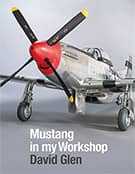Empennage 1: The elevators
Wednesday, 11th June, 2014
With my workshop by now ankle deep in balsa chips, I made the decision come early May to tackle the last remaining woodwork – tail plane, elevators, rudder and the twin radiator fairings – before taking a break for a ‘spring clean’!
Work on the tail plane follows very closely that of the main planes, which I have described previously, so I will leave this stage primarily to my pictures and captions. One departure, however, was my use of basswood rather than balsa to build up the leading edge, the logic being that the harder wood may prove advantageous when it comes metal skinning. So tight are the counter curvatures here that when building my first big Spitfire I was compelled to use a separate former over which to shape the annealed metal. Perhaps this time I will be able to do it in situ.
The elevator and rudder are fabric covered, so the objective is to simulate the open frame construction of the original. This entails starting with a very much thinner plywood sheet to cater for the trailing edge. And, since it is preferable to build the elevator and tail plane effectively as one piece, a packing layer is needed to cater for the thickness differential: specifically, the tail plane is built over 4mm ply and the elevator over 1mm ply, so the packing on the building board must be 1.5 mm. This is shown clearly in my photos.
I mentioned my method for attaching the ailerons to the wing in my blog of April 1, and a similar technique is used here. Thus the first task is to cut slots in the thin ply to accommodate four 4mm (outside diameter) alloy tubes, taking care that they align exactly with their counterparts embedded in the tail plane. Next the elevator trim tabs are cut away and re-fitted, also with a compliment of proportionally smaller attachment tubes. Then, with all the tubes and their telescoping rods assembled together and everything screwed down flat on the building board, work starts in earnest.
The leading edge of the elevator describes a semi-circle, and to capture this accurately I turned a length of wood dowel in the lathe to the required diameter and taper and then cut it lengthwise into quadrants using my gig-saw. Next the trailing edge, and here I made a blunder. In order to simulate (after sanding) the wedge-shaped section, it seemed convenient to use lengths of flexible styrene strip – until I realised that this might not be such a good idea, given the need to use heat during the fabric covering process. It took considerable patience and a sharp scalpel blade to remove the offending plastic and to replace it with hand-cut curved strips of 0.5mm ply.
I cut the half-ribs from 2.5mm ply and glued them in place abutted to the dowel quadrants. They are slightly over scale in thickness, but that’s not such a bad thing given the need for fabric adhesion. The leading edge of the Spitfire’s elevator is metal clad, resulting in a distinctive zigzag line discernable through the fabric, and I built this up piecemeal from numerous little balsa triangular and rectangular blocks emplaced between the ribs. This proved tedious, time-consuming and prone to error, and I’m sure there is a more efficient solution. As part of the process I glued in the larger balsa blocks from which to shape the solid inboard and outermost sections, including the extreme tips which are reinforced with basswood. That left the trimmer tabs to flesh out with scraps of balsa prior to detaching the job from the baseboard and repeating the entire process on the reverse side.
Apart from the tips and inboard sections, sanding the planar surfaces was easy, involving merely levelling any excess balsa down to the ribs, which I customarily paint red as a guide, and I left this until both elevator halves were complete. At this stage I gave the entire piece several coats of automotive spray primer, which not only reveals areas for additional filler and refinement, but should also help prevent any potential warping through damp ingress. It also helped with the final task of cutting the four matched recesses in the leading edge. These open over the hinge linkages, where any inaccuracy would be accentuated by juxtaposition to each other and to the tail plane’s trailing edge, so I took special care with the marking out and made the initial cuts with the job propped horizontally on my gig-saw table.
Apart from the simple aluminium alloy channels that enclose the trimmer tab leading edges, I leave the job here for the time being. Detailed fittings will be made when I do the fabric covering – still a distant prospect at this stage in the model.








